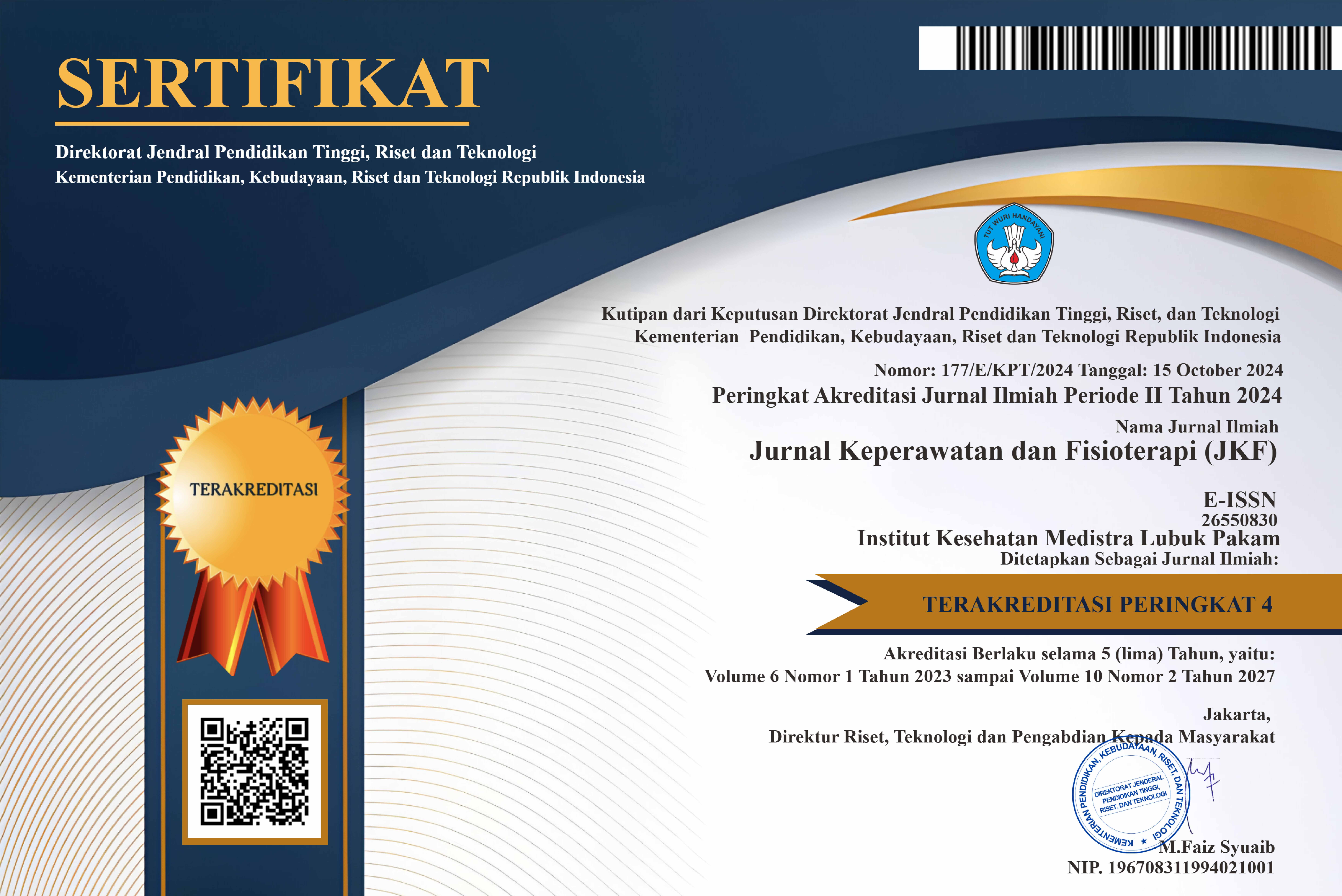The Ethnic Group Role With Stunting Incidents In Sekip Village Lubuk Pakam District
DOI:
https://doi.org/10.35451/jkf.v5i2.1675Keywords:
Stunting and Ethinc GroupAbstract
Stunting is a condition where toddlers have less length and height compared to their peers. Stunting is one of the focuses of the 2nd Sustainable Development Goals (SDGs), namely eliminating hunger and all forms of malnutrition by 2030 and achieving food security. The World Health Organization (WHO) sets a maximum limit of 20% or one fifth of the total number of toddlers. This study aims to determine the role of local culture in the incidence of stunting in Sekip Village, Lubuk Pakam District. This type of quantitative research, is an analytic survey with a cross sectional design. The sample size is 62 mothers who have toddlers with a purposive sampling technique, using a questionnaire sheet. Based on the results of the Chi Square test it was found that local culture played a role in stunting with a value of p = 0.017 <? (0.05). The conclusion of this study is that culture has a role in the incidence of stunting. Suggestions for cross-sectoral collaboration involving community leaders in the context of providing education about stunting
Downloads
References
Aryastami, N. K. (2017). Kajian Kebijakan dan Penanggulangan Masalah Gizi Stunting di Indonesia. Buletin Penelitian Kesehatan, 45(4), 233–240. https://doi.org/10.22435/bpk.v45i4.7465.233-240
Dinkes Deli Serdang. (2019). Profil Kesehatan Deli Serdang 2019.
FAO. (2021). Global report on food crises. Food Security Information Network, September, 1–202. https://www.wfp.org/publications/2020-global-report-food-crises
Fuadi, T. M. (2018). Budaya Mee Bu bagi Penurunan Stunting: Kearifan Lokal Aceh dalam Proses Reproduksi. Jurnal Biologi Edukasi, 10, 1–7.
Gluckman, P. (2005). The Fetal Matrix. Evoluation, Development and Disease. In Cambridge University Press.
Kemenkes. (2013). Riset Kesehatan Dasar. In Kementerian Kesehatan RI (Vol. 7, Issue 5). https://doi.org/10.1517/13543784.7.5.803
Kemenkes. (2019). Kementerian Kesehatan Republik Indonesia. Kementerian Kesehatan RI, 1(1), 1. https://www.kemkes.go.id/article/view/19093000001/penyakit-jantung-penyebab-kematian-terbanyak-ke-2-di-indonesia.html
Kemenkes RI. (2018). Cegah Stunting, itu Penting. Pusat Data Dan Informasi, Kementerian Kesehatan RI, 1–27.
Kementerian Kesehatan RI. (2018). Laporan Hasil Riset Kesehatan Dasar (Riskesdas) Indonesia tahun 2018. In Riset Kesehatan Dasar 2018 (pp. 182–183).
Kominfo. (2022). Pemprov Sumut optimis target penurunan stunting 2024 tercapai. https://infosumut.id/pemprov-sumut-optimis-target-penurunan-stunting-2024-tercapai/
Masitoh, S. (2022). BKKBN: Rokok Jadi Faktor Indoensia Duduki Posisi 108 Stunting di Dunia. https://nasional.kontan.co.id/news/bkkbn-rokok-jadi-faktor-indoensia-duduki-posisi-108-stunting-di-dunia
Natalia, E., & Ping, M. F. (2020). Kearifan Lokal Dan Pengetahuan Ibu Terhadap Status Gizi Dan Pola Makan Pada Kejadian Stunting Usia Preschool. Dunia Keperawatan: Jurnal Keperawatan Dan Kesehatan, 8(3), 435. https://doi.org/10.20527/dk.v8i3.9163
Ningtyias, F. W., & Kurrohman, T. (2018). Preventing stunting in Osing Tribe: The Study of Phenomenology of Food Taboo’s and Recomended Food For Pregnan Woman. Prosiding:Simposium Internasional Gizi Dan Pangan I (2018) “Preventing Stunting Through Food and Nutrition Family Self-Sufficiency in The First 1000 Days of Life,” 31–39.
Nugroho, M. R., Sasongko, R. N., & Kristiawan, M. (2021). Faktor-faktor yang Mempengaruhi Kejadian Stunting pada Anak Usia Dini di Indonesia. Jurnal Obsesi : Jurnal Pendidikan Anak Usia Dini, 5(2). https://doi.org/10.31004/obsesi.v5i2.1169
Nurbaiti, L., Adi, A. C., Devi, S. R., & Harthana, T. (2014). Kebiasaan makan balita stunting pada masyarakat Suku Sasak: Tinjauan 1000 hari pertama kehidupan (HPK). Masyarakat, Kebudayaan Dan Politik, 27(2), 104. https://doi.org/10.20473/mkp.v27i22014.104-112
Putriana, A. E., Masfufah, M., & Kariani, N. K. (2020). Stunting berdasarkan Budaya Makan Suku Makassar, Toraja dan Bugis. Jurnal Gizi Kerja Dan Produktivitas, 1(2), 25. https://doi.org/10.52742/jgkp.v1i2.9349
Rokom. (2023). Prevalensi Stunting di Indonesia Turun ke 21,6% dari 24,4%. https://sehatnegeriku.kemkes.go.id/baca/rilis-media/20230125/3142280/prevalensi-stunting-di-indonesia-turun-ke-216-dari-244/
Syamsuddin, I. O. (2020). Pembkab Buton cegah stunting lewat budaya kearifan lokal. https://www.satukanegeri.co.id/post/39006/pemkab_buton_cegah_stunting_lewat_budaya_kearifan_lokal
TNP2K. (2017). 100 Kabupaten/Kota Prioritas untuk Intervensi Anak Kerdil (Stunting).
WHO. (2020). Childhood Stunting: Context, Causes and Consequences - Conceptual framework. 9(September).
Downloads
Published
Issue
Section
License
Copyright in each article is the property of the Author.


























